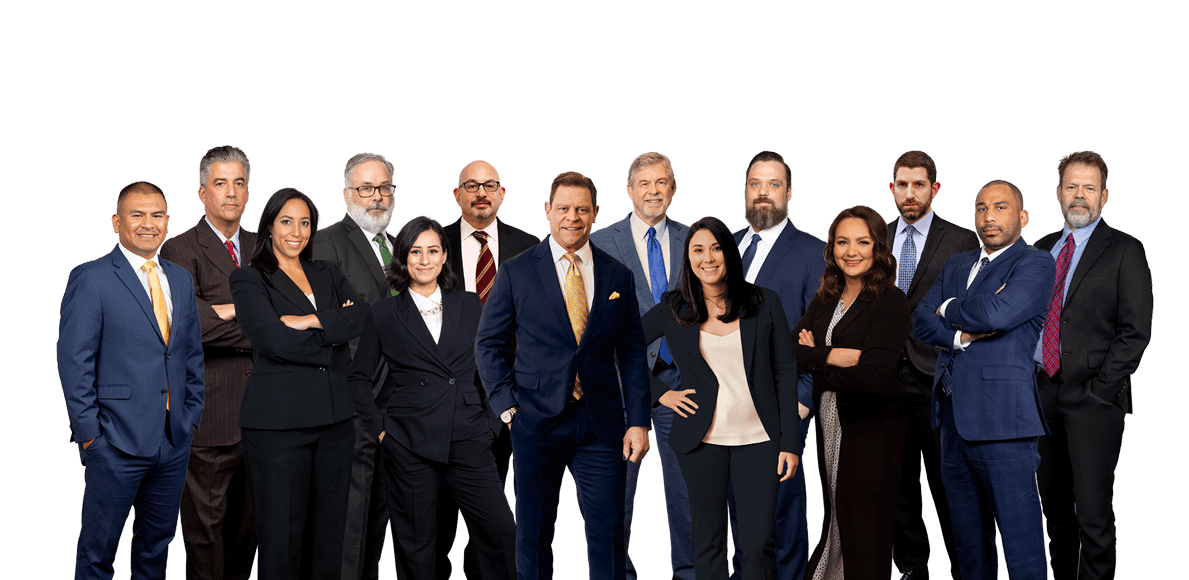T-bone accidents happen when a car strikes the side of another vehicle, with the moment of impact resembling an upper-case “T.” These are among the most serious accidents, with the Impact Medical Group reporting 23% of accident fatalities resulting from them.
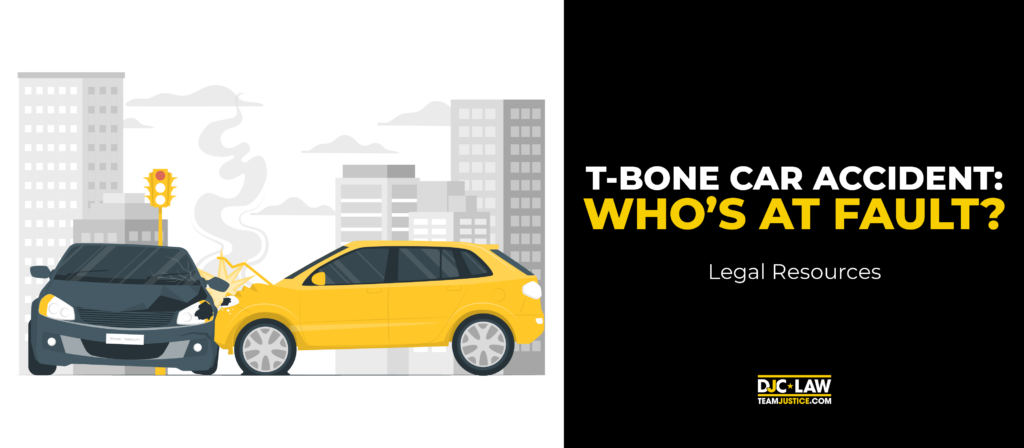
The severity of these crashes is so significant because the side of the vehicle is where you’re least protected. Even though many cars have side airbags, you essentially have nothing more than a flimsy door and a piece of glass to protect you.
Determining who is at fault in a T-bone accident depends on the circumstances. In some cases, both drivers could be at fault. In this guide, we discuss the factors contributing to determining T-bone accident fault.
Key Takeaways
-
Fault in a T-bone accident is assigned primarily to the driver who violated the right of way of the other vehicle. It’s not a matter of whom T-boned whom but who failed to yield when they should have done.
-
T-bone fault is determined by assessing various factors, including speeding, reckless and distracted driving, traffic law violations, and right-of-way violations. Note that both parties could be assigned fault.
-
After a T-bone accident, you can seek to claim through the other driver’s insurance company or file a personal injury claim with your attorney.
T-bone crashes are among the deadliest accidents, with injuries like whiplash, broken bones, herniated discs, and brain and spinal cord injuries.
If you’re involved in a T-bone collision, seek medical attention immediately, call the police, and gather evidence that you can use to pursue your claim through a Texas accident attorney later.
Who is at Fault for a T-Bone Accident?
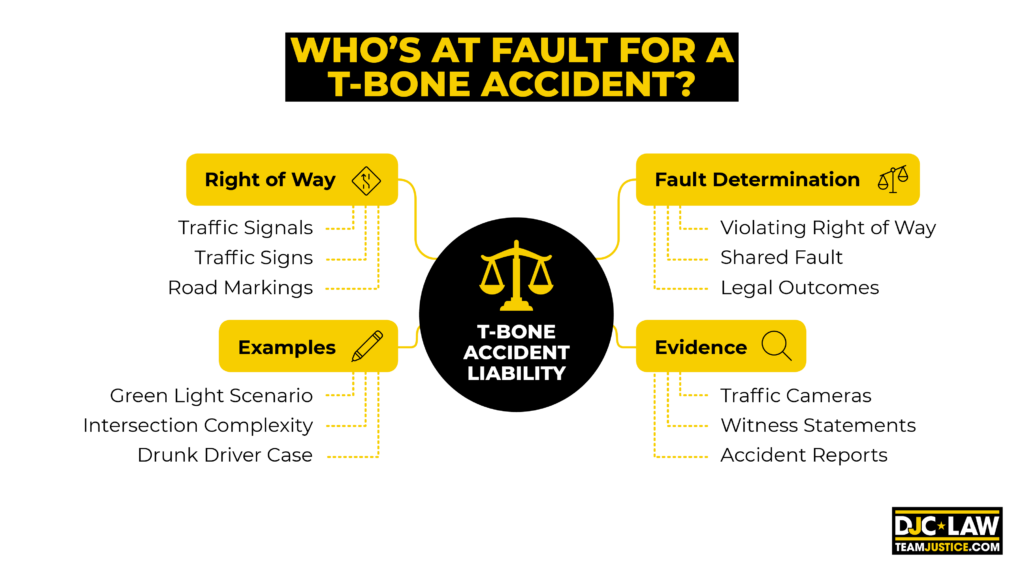
T-bone fault isn’t determined by whom t-boned who. Instead, lawyers operate on the principle of which vehicle had the right of way and which vehicle violated that right of way. Typically, the driver who violated the right of way will be declared the guilty party, but even the driver who had the right of way could be assigned some level of fault because of actions they took or didn’t take.
Investigating a T-bone accident is tricky because who had the right of way isn’t always clear and obvious. For example, The Zebra reported that T-bones make up 10% of all car crashes, with most occurring at intersections. Determining the right of way is a relatively simple matter in these environments because of the presence of traffic cameras.
For example, if you were going through a green light and a drunk driver barreled through from another direction and T-boned you, the fact you were moving straight at a green light means you almost certainly had the right of way.
Sadly, not all T-bone accidents are that clear-cut.
Factors Influencing Fault
Several factors influence fault in T-bone crashes. Right-of-way violations, speeding, reckless driving, traffic law violations, and driver intoxication are all factors in deciding who was at fault.
Understanding each of these factors is critical to determining liability:
-
Right of Way – The driver who violated the right of way will almost always be blamed for a T-bone crash. For example, this could be failing to stop at a stop sign or running a red light.
-
Speeding – Speed kills because it gives you less time to react to danger and increases the impact of a crash. CivicData reported just one-third of drivers admitted to adhering to the speed limit all the time. If you were speeding, this could see you assuming blame for the accident.
-
Reckless Driving – Driving recklessly could mean you were breaking the law or performing unsafe behaviors that led to the collision in the first place.
-
Traffic Law Violations – Violating traffic laws, such as texting while driving or talking on the phone, could divert your attention, meaning you could not see an oncoming driver until it was too late. The Department of Transportation found that 18% of drivers in crashes were engaged in at least one non-driving activity at the time.
-
Driver Intoxication – Driving while impaired due to alcohol or drugs limits reaction times and coordination. It also makes it likelier that you’ll engage in riskier driving behaviors. In such cases, you could be held liable for the T-bone collision.
Note that some situations could mean both drivers are assigned fault. If it was found that the driver who was T-boned had the right of way but they were speeding or intoxicated, this could cause their final settlement amount to be reduced.
How to Determine Fault
T-bone fault is determined by evaluating all available evidence, including traffic camera footage, official police accident reports, the damage to the vehicles, testimonies from the drivers involved, and eyewitness reports.
If there was a blatant traffic violation, determining fault is often relatively straightforward. However, when fault is contested, it requires a personal accident attorney to evaluate the evidence. It may also mean bringing in an expert, such as an accident reconstructionist, to provide an in-depth view of what happened.
What Are Your Legal Options After a T-Bone Accident?
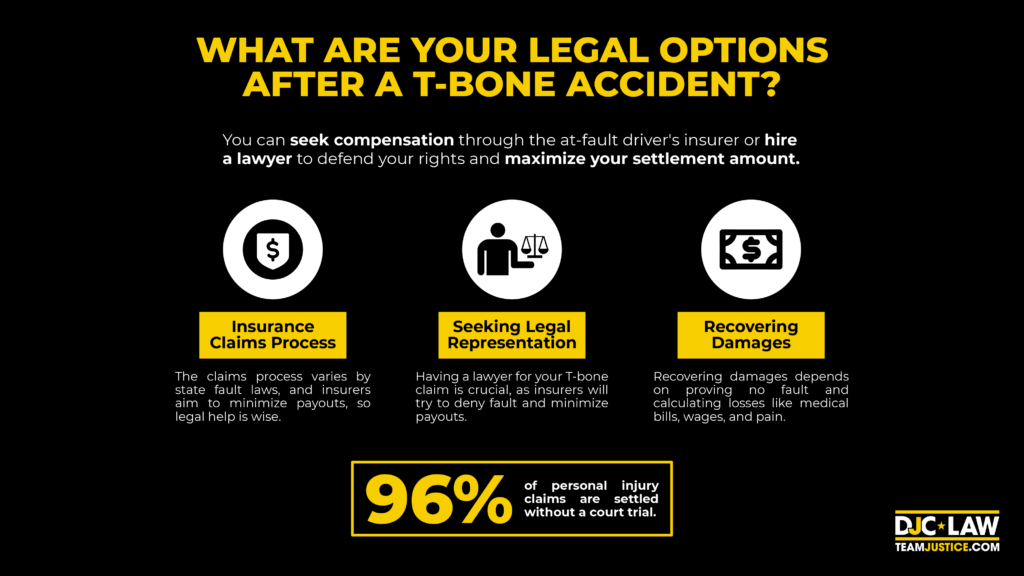
Like any type of car wreck, you have the right to be compensated for your losses. Options include claiming through the auto insurance company of the at-fault driver or hiring a lawyer to pursue a personal injury lawsuit.
Always enlist the help of a lawyer to fight your case, even if you agree to a settlement with your insurer. They’ll defend your rights, maximize your settlement, and give you the breathing space needed to put your life back together.
Insurance Claims Process
The insurance claims process depends on your state’s fault laws. If you live in an at-fault state like Texas, you’ll file a claim with the at-fault driver’s insurer. In a no-fault state, you’ll claim your own insurance company.
Each auto insurer will have its own claims process. Like any lawsuit, you’ll need to prove fault and then prove that you experienced losses. Remember, the insurer isn’t your friend. It’s their job to pay out as little as possible, which is why it’s wise to seek legal representation.
Depending on the circumstances, the claims process could take a few weeks or even a few years.
Seeking Legal Representation
Enlisting a lawyer to pursue your T-bone claim is vital because insurers will do everything they can to prove their driver wasn’t at fault, that you may have contributed to the accident, or that your injuries aren’t as serious as you claim.
Countless cases of auto insurance companies acting in bad faith exist. Your lawyer will take control of negotiations, stop the incessant calls, and build a case that the insurer can’t refute. Moreover, if you absolutely have to proceed to a court trial, a car accident attorney guides you throughout the process.
The biggest mistake car accident victims make is to attempt to fight their own cases.
Recovering Damages
Recovering damages and securing a settlement relies on proving you weren’t at fault and then coming up with a figure that matches your losses. Personal injury attorneys explore every avenue to recover the maximum amount.
Examples of damages you can claim include:
-
Medical expenses
-
Car repair bills
-
Personal property damage
-
Lost wages
-
Future lost earnings potential
-
Pain and suffering
-
Loss of companionship
-
Loss of quality of life
Usually, your lawyer will negotiate with the insurance company and win you a fair settlement. Once you’ve signed the settlement agreement, the insurer will send a check. Very rarely will you have to attend court, with Nolo reporting that 96% of personal injury claims are settled without a court trial.
What Compensation is Available After a T-Bone Accident?
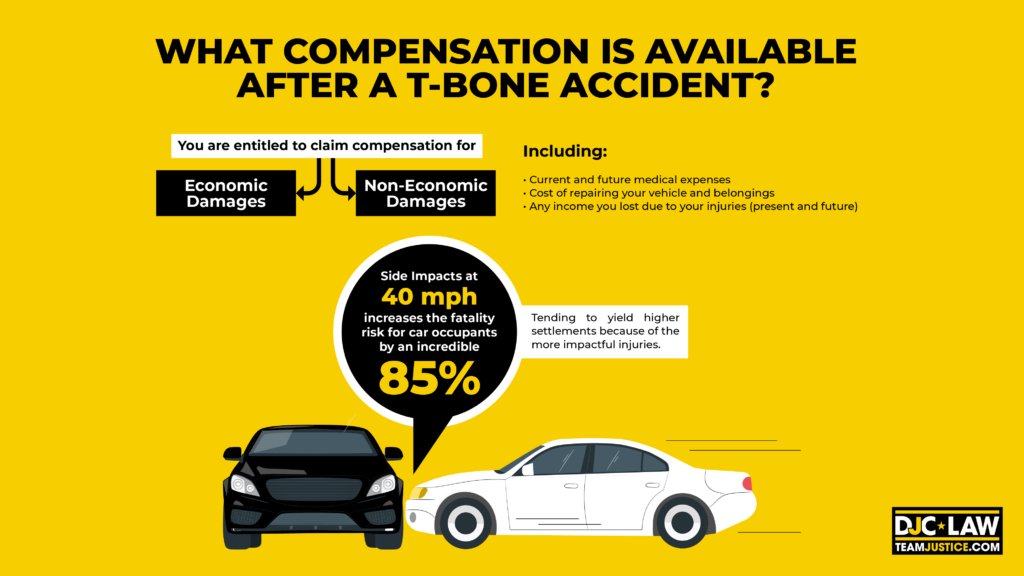
You are entitled to claim compensation for economic and non-economic damages after a T-bone accident. That includes your current and future medical expenses and the cost of repairing your vehicle and belongings. Any income you lost due to your injuries, present and future, is also on the table.
But what’s the average settlement for a car accident? All car accidents are unique, but T-bones tend to yield higher settlements because of the more impactful injuries. For example, the World Health Organization (WHO) reported that side impacts at 40 mph increase the fatality risk for car occupants by an incredible 85%.
Your attorney will explore every avenue when determining your losses and building a case for why that’s a suitable dollar figure. Non-economic damages like pain and suffering can make up a substantial part of your settlement.
Generally, anything you’ve lost as a direct cause of the accident is on the table in compensation terms.
How Your Attorney Will Prove Liability
Your attorney will prove liability by gathering as much evidence as possible about the accident and the seconds before the accident. Using an array of evidence, they’ll paint a picture of what happened and who was at fault.
In every case, your San Antonio car accident lawyer will want to see:
-
A copy of the official police report.
-
Photos of your injuries.
-
Photos of the damage to both vehicles.
-
Your medical records.
-
Your medical bills.
-
Witness statements
-
Video footage from nearby cameras.
-
Weather reports.
They’ll use all this evidence and may even call in professionals, such as expert witnesses, to create the strongest case possible.
What Type of Injury is Commonly Associated With T-Bone Accidents?
Given the proximity of vehicle occupants to the point of impact, T-bone accident injuries are usually severe and can also lead to long-term physical and psychological trauma. The IIHS reports that they cause the second most fatalities of any accident type, just behind frontal impacts.
Let’s discuss the most common types of injury arising from T-bone accident victims.
Whiplash
Whiplash is often associated with rear-end accidents, but it’s also a typical result of T-bone incidents. It’s a neck injury caused by the sudden back-and-forth movement of the neck, with the effect of the cracking of a whip.
Approximately three million Americans sustain whiplash every year, according to a report from Brookdale Health. It can result in loss of range of motion, pain, headaches, and tingling sensations in your extremities. Without treatment, whiplash can become chronic.
One of the biggest problems with whiplash is that the symptoms may not appear until days after the crash.
Chest Injuries
When a T-bone crash causes the door to intrude or the seatbelt to lock suddenly, the chest often takes the brunt of the impact. This can lead to bruised or fractured ribs, lung damage, or internal bleeding. Some chest injuries may not be immediately obvious, making early medical evaluation critical.
Broken Bones
Car occupants are more exposed to the brutal, blunt-force trauma of a crash when they’re hit from the side. The force of the impact can result in bones breaking and fracturing. Affected areas include the skull, neck, pelvis, and clavicle.
Sustaining broken bones can prevent you from going about your business for months before they fully heal, especially if the break is severe.
Head and Brain Injuries
The head is especially vulnerable to T-bone car accidents because of what happens to the head. Your head has a high likelihood of violently hitting another passenger, side window, dashboard, steering wheel, and side airbag.
Injuries range from concussions to life-threatening brain bleeding. These types of traumatic brain injuries are among the most life altering injuries a person can suffer, often leading to permanent cognitive or emotional challenges.
Like whiplash injuries, traumatic brain injuries may not appear immediately. Common symptoms include:
-
Migraines
-
Nausea
-
Memory loss
-
Confusion
-
Blurry vision
-
Tinnitus
-
Difficulty sleeping and speaking
-
Unexplained mood swings
In all cases, a suspected brain or head injuryshould necessitate an immediate visit to the emergency room. Without prompt medical treatment, these are the severe injuries that could turn life-threatening.
Herniated Disc Injuries
Herniated discs occur when the force of the crash causes a vertebra to be pushed into the spinal canal. It can put pressure on the nerves around your spinal cord, leading to chronic back and neck pain.
According to the Vancouver Disc Center, as many as 25% of whiplash victims also suffer from herniated discs, making it one of the most common T-bone accident injuries. Severe herniations may necessitate surgery.
Note that not all cervical herniated disc injuries will lead to symptoms. If this is the case, you’ll need an MRI to see that you’ve herniated one of your discs.
Hidden Injuries
Hidden injuries are any type of injury that isn’t immediately apparent. Internal bleeding and organ damage are among the most serious internal injuries. If you don’t seek immediate medical attention or act upon your symptoms in the days and weeks after your accident, you could be putting your life at risk.
Spotting hidden injuries means monitoring symptoms and taking even the most minor signs seriously.
Examples of delayed injury symptoms to look for after a car accident include:
-
Headaches
-
Back pain
-
Skin color changes
-
Abdominal pain
-
Shoulder problems
-
Fatigue
-
Loss of range of motion
-
Many people pass off these symptoms because they might not interfere with your daily life, but it’s vital to act immediately. Prompt treatment could prevent you from acquiring chronic issues later or even save your life.
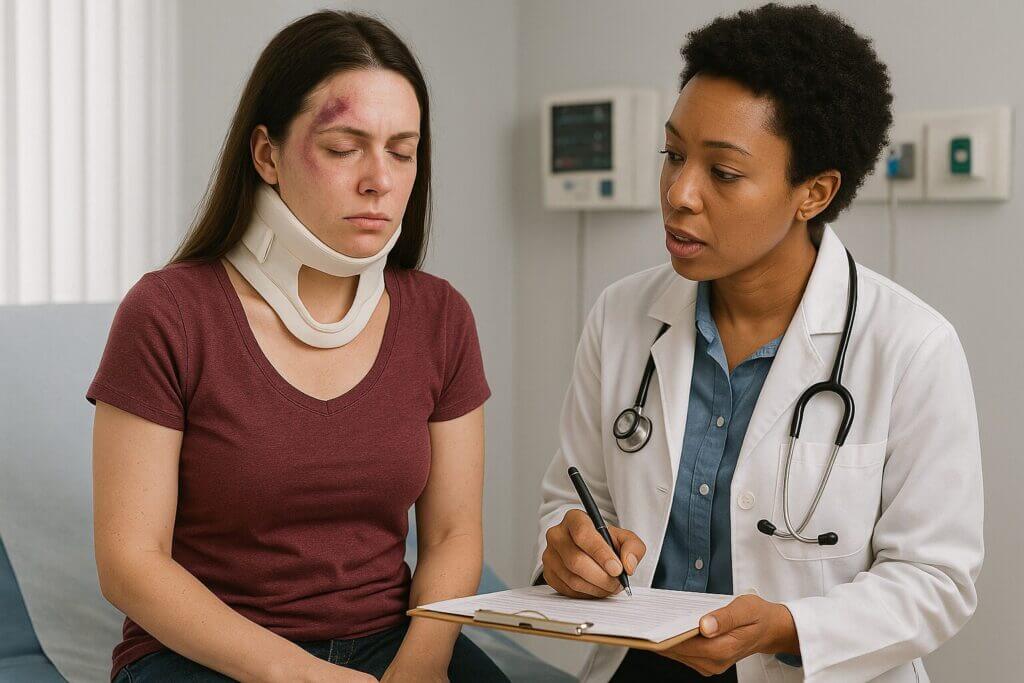
What Causes T-Bone Car Accidents?
T-bone car accidents can occur just about anywhere. Still, most happen in three scenarios: at four-way intersections, while turning left across oncoming traffic, or when backing out of a parking space. Likewise, T-bone collisions occur when drivers ignore traffic signals or fail to pay attention to their surroundings.
Here’s how most T-bone crashes happen:
-
Four-Way Intersection – Two drivers enter a four-way intersection at the same time, and both cars collide. These usually happen because of a driver error, like running a yellow light or ignoring a stop sign.
-
Left Turn Across Oncoming Traffic – One driver turns left across oncoming traffic. Simultaneously, another driver enters the intersection, causing them to slam into the other driver’s side. The most common cause of this accident is misjudging the speed and distance of the other driver.
Backing Out of a Parking Space – The driver of one vehicle attempts to back out of a parking space, but another driver slams into the side of the vehicle. The one driver backing out of a space probably had their vision obscured by other cars, while the second driver was moving too quickly. It’s why parking lot speed limits are so low.
Statute of Limitations for a T-Bone Accident Claim in Texas
The statute of limitations for all car accident types in Texas is set at two years from the date of the accident. Under specific circumstances, such as if the victim was a minor, there are exceptions to this rule.
Under the Texas statute of limitations, you must file your claim before the two-year limit elapses. It only applies to when you file your case officially, not how long the case takes to resolve.
Despite a generous two-year limit, we recommend filing your case immediately so that your memory of the incident is fresh and you don’t have to wait longer than necessary to secure a settlement.
Steps to Take After a T-Bone Car Accident
Following a T-bone car accident, it’s vital to prioritize your health and well-being. It’s also an excellent chance to collect evidence that can be used to pursue your claim later. Above all, call a personal injury lawyer to begin filing your claim as soon as possible.
In the immediate aftermath of the T-bone impact, follow these steps:
-
Step One – Check yourself for injuries and get to safety. Do the same for your passengers. If you’re in immediate danger, call for an ambulance.
-
Step Two – Call the police and report your auto accident. It’s your obligation to report the accident to the police. Moreover, the attending officer can fill out an official policy accident report, which will serve as vital evidence later.
-
Step Three – Take pictures of the accident scene. Focus on the damage to both vehicles, the road conditions, any road signs, and any visible injuries.
-
Step Four – Attempt to solicit eyewitness reports from anyone who might have seen what happened. Note that they don’t have to cooperate or provide contact details, so you’ll have to accept that if they refuse.
-
Step Five – Exchange your details with the other driver. You’re legally obligated to give them your name and insurance details. If the other driver refuses, they’re breaking the law, which should be reported to the attending officer.
Step Six – Get yourself to a medical center for a check-up. Even if you feel fine after your accident, it can take some hours for symptoms to appear. Keep copies of all documentation you receive. Injury victims often underestimate the long-term cost of their medical care, which is why documenting every symptom and diagnosis is essential for your legal case.
-
Step Seven – Call a Texas car accident attorney for your free consultation. They’ll be able to begin acting on your behalf immediately, including dealing with the other driver’s insurance company. It’s best to get this out of the way as soon as possible because the faster you file your case, the faster you can receive a settlement.
Look out for additional symptoms in the days and weeks after your accident. Your initial medical evaluation might not flag everything immediately. Be vigilant, and don’t pass anything off as “minor” because it could indicate a hidden injury.
T-Bone Car Accident FAQs
Where Do T-Bone Accidents Usually Occur?
Broadside collisions usually occur at intersections because this is where two vehicles are likely to cross at a single point. Angle collisions are among the deadliest types of accidents because of the limited protection occupants have.
Statistically, a side impact collision will usually hit the passenger side of the vehicle at an intersection. However, the driver’s side of the vehicle could take the most damage if someone runs a red light or a stop sign.
Can Both Parties Be at Fault for a T-Bone Collision?
Yes, both parties could be assigned fault for a T-bone accident. Whoever violated the right of way will be considered the primary contributor to an accident, but extenuating circumstances could result in the victim taking partial blame.
If you’re assigned partial blame for a T-bone incident, this will see your final compensation award reduced by a set percentage.
Should I Talk to an Insurance Adjuster After a T-Bone Accident?
Never speak to the other driver’s insurer or an insurance adjuster about your accident. Hand this problem over to your attorney. Above all, never consent to provide a recorded statement. Adjusters are trained to twist your words and ask open-ended questions so that they can use your statement against you later.
There’s absolutely no advantage to dealing with the other driver’s insurance company directly because the only thing they want to do is reduce how much the other driver’s negligence costs them.
